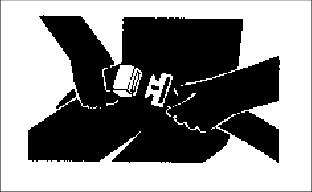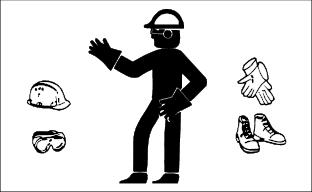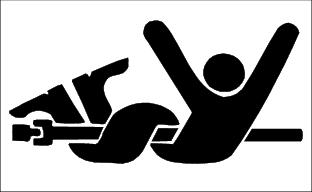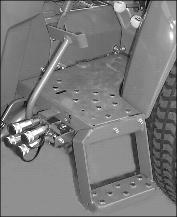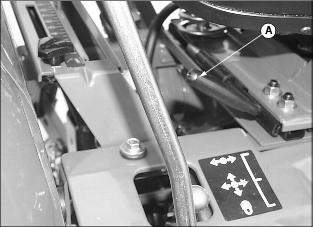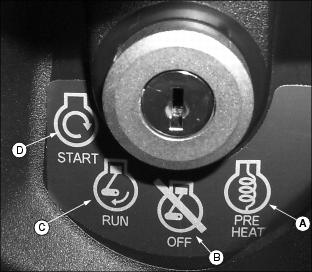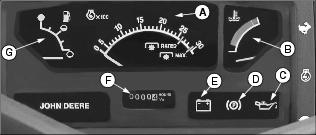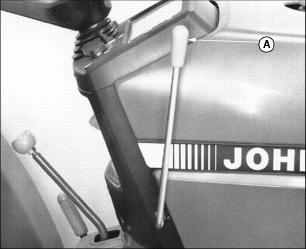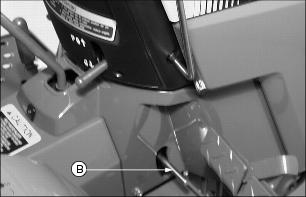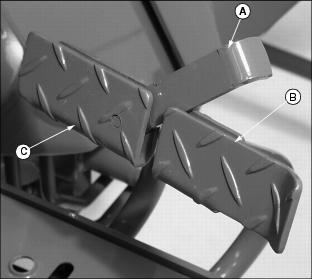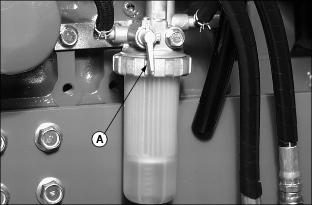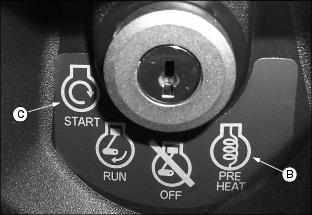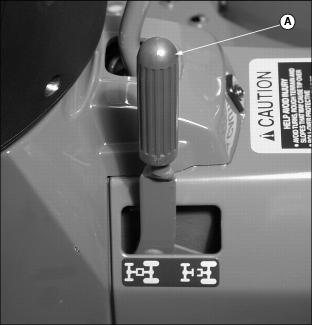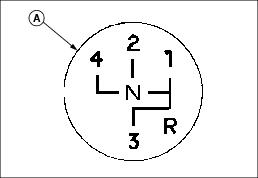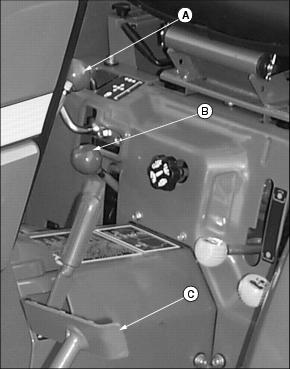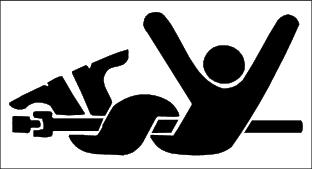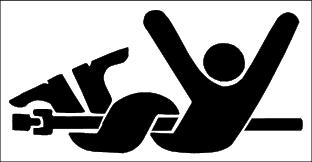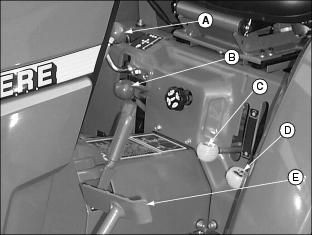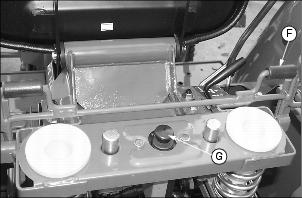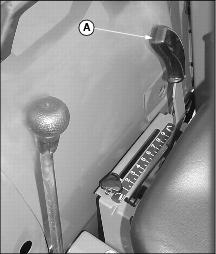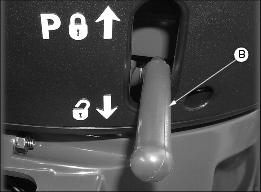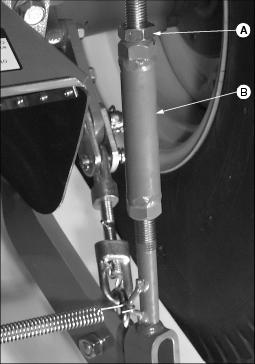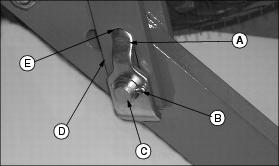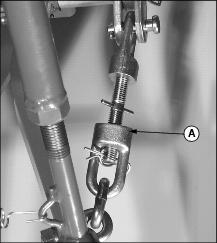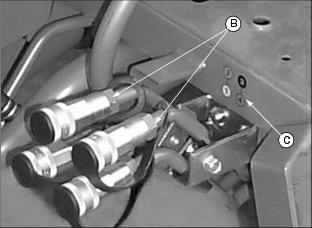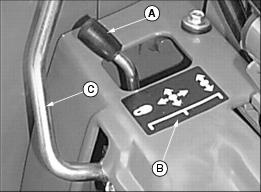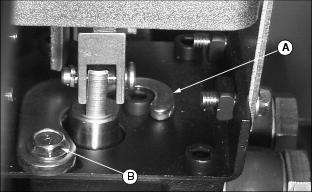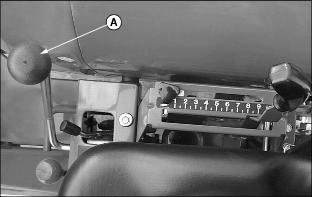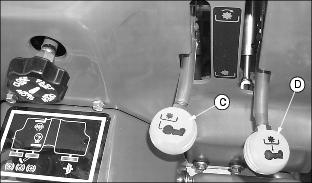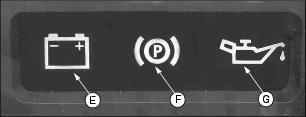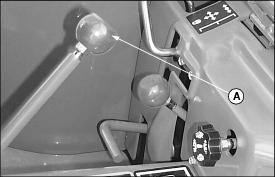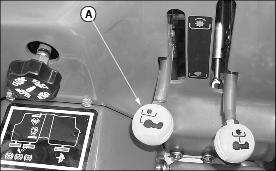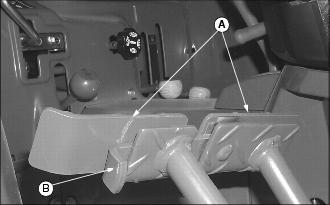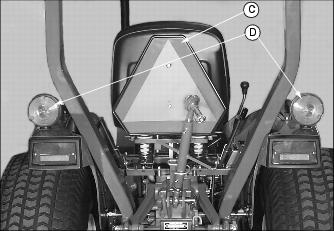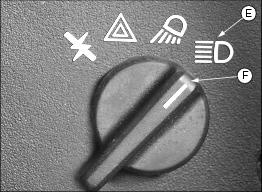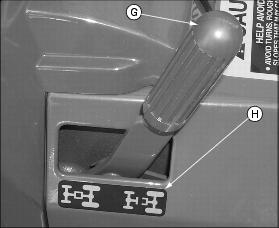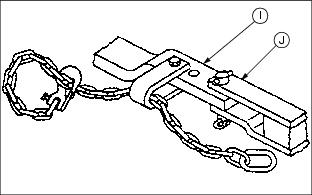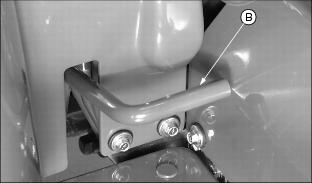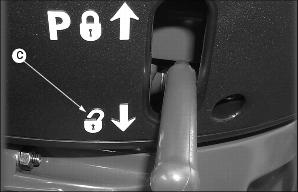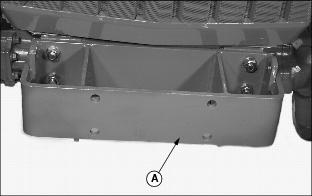Compact Utility Tractor with Gear Transmission
Introduction
Safety Signs
Controls
Operating
Rotating Blades Are Dangerous - Protect Children And Prevent Accidents
Stay Clear of Rotating Drivelines
Understanding Instrument Panel
Cold Weather Starting Procedure Using Intake Air Heater System
Restarting An Engine That Has Stalled
Restarting An Engine That Has Run Out Of Fuel
Operating Optional Front Wheel Drive (4WD)
Operating Sliding Gear Transmission
Using Power-Take-Off (PTO) - (Operator ON Seat)
Using Power-Take-Off " (PTO) - (Operator OFF Seat)
Using Speed of Drop/Lock Valve
Adjust Implement Side-to-Side Sway
Using Optional Hydraulic Selective Control Valve (SCV)
Using Selective Control Valve (SCV) Safety Lock
Using Selective Control Valve (SCV) Regenerative Circuit
Connecting Attachment Hydraulic Hoses
Safety Interlock System Checkout Procedure
Selecting Front Tire Rolling Direction
Using Front Weights (Optional)
Using Rear Cast Iron Wheel Weights (Optional)
Using Optional Rear Ballast Box
Replacement Parts
Service Machine Safely
Service Intervals
Service Engine
Service Transmission
Service Electrical
Service Miscellaneous
Troubleshooting
Storing Machine
Assembly
Specifications
Warranty
John Deere Service Literature
John Deere Quality Statement

Operating
Operate Safely
· Check brake action before you operate. Adjust
or service brakes as necessary.
· Inspect machine before you operate. Be sure hardware is tight. Repair or replace damaged, badly worn, or missing parts. Be sure guards and shields are in good condition and fastened in place. Make any necessary adjustments before you operate.
· Clear work area of objects that might be thrown. Keep people and pets out of the work area. Stop machine if anyone enters the area.
· If you hit an object, stop and inspect the machine. Make repairs before you operate. Keep machine and attachments properly maintained and in good working order.
· DO NOT leave machine unattended when it is running.
· Only operate during daylight or with good artificial light.
· Be careful of traffic when operating near or crossing roadways.
· Do not wear radio or music headphones while operating the machine. Safe operation requires your full attention.
Park Safely
· Stop machine on a level surface, not on a slope.
· Before you leave the operator's station, wait for engine and all moving parts to STOP.
Use Seat Belt Properly
Use a seat belt when you operate with a Roll-Over Protective Structure (ROPS) to minimize chance of injury from an accident, such as an overturn.
Do not use a seat belt if operating without a ROPS.
Rotating Blades Are Dangerous - Protect Children And Prevent Accidents
· Never assume that children will remain where you last saw them. Children are attracted to mowing activity, stay alert to the presence of children.
· Keep children in the house when you are operating the machine.
· Turn machine off if a child enters the mowing area.
· Use extra care when you come to blind corners, shrubs, trees, or other objects that may block your vision.
· DO NOT let children or an untrained person operate the machine.
· DO NOT carry or let children ride on machine or any attachment. DO NOT tow children in a cart or trailer.
HELP PREVENT SERIOUS OR FATAL ACCIDENTS:
· Be alert at all times, drive forward carefully. People ESPECIALLY CHILDREN can move quickly into the mowing area before you know it.
· Back carefully. Shut off PTO and look behind the machine carefully, ESPECIALLY FOR CHILDREN, before you back up.
· DO NOT mow in reverse unless it is absolutely necessary.
· Shut off PTO when you are not mowing.
· DO NOT operate machine if you are under the influence of drugs or alcohol.
Operator Training Required
· Study operating section of this manual before operating the machine.
· Operate machine in an open, unobstructed area under the direction of an experienced operator.
· Learn the use of all controls.
· Operator experience is required to learn the moving, stopping, turning and other operating characteristics of the machine.
Avoid Tipping
· DO NOT drive where machine could slip or tip.
· Stay alert for holes and other hidden hazards in the terrain.
· Slow down before you make a sharp turn or operate on a slope.
· When pulling loads or using heavy equipment, use only approved hitches, limit loads to those you can safely control, and use counterweights or wheel weights when required per this manual or your attachment manual.
· Drive up and down a hill - not across. Be careful when you change direction on a slope.
· DO NOT stop when going up hill or down hill. If machine stops going up hill, STOP PTO and back down slowly.
· DO NOT mow wet grass. Reduced traction could cause sliding.
Check Wheel Bolts
· A serious accident could occur causing serious injury if wheel bolts are not tight.
· Check wheel bolt tightness at the following interval:
· After 10 hours of operation.
· Often during the first 100 hours of operation.
Keep Riders Off
· Only allow the operator on the machine. Keep riders off.
· Riders on the machine or attachment may be struck by foreign objects or thrown off the machine causing serious injury.
· Riders obstruct the operator's view resulting in the machine being operated in an unsafe manner.
Wear Appropriate Clothing
· Wear close fitting clothing and safety equipment appropriate for the job.
· Loud noise can cause impairment or loss of hearing, wear a suitable protective device such as earplugs.
Stay Clear of Rotating Drivelines
Entanglement in rotating driveline can cause serious injury or death:
· Wear close fitting clothing.
· STOP the engine and be sure PTO driveline is stopped before getting near it.
Transport Safely
· Use safety lights and devices. Slow moving machines when driven on public roads are hard to see, especially at night. Avoid personal injury or death resulting from a collision with a vehicle.
· Whenever driving on public roads, use flashing warning lights and turn signals according to local regulations. Extra flashing warning lights may need to be installed.
Using Step
The step is located on LH side of tractor.
Adjusting Operator Seat
Before starting engine to drive tractor, adjust operator seat to desirable position.
Select Seat Position
1. Move seat positioning lever (A) up and
2. slide seat forward or rearward to desired position.
3. Release lever to lock seat in position. Make sure all controls can be easily accessed.
Using Seat Belt
1. Adjust seat belt (A) for proper fit and connect as shown. Listen for a click when inserted properly into latch. To release seat belt, press button (B).
2. When the seat belt is not being used, push ends of seat belt onto holders (C) located on both fenders.
Using Ignition Key Switch
A - "PREHEAT/Cold Starting" Position - Rotate the key to this position to allow the engine to preheat. The engine should not run.
B - "OFF" Position - With the key in this position, all switched power is off, and the the engine should not run.
C - "RUN" Position - Rotate the key to this position and the Engine Oil Pressure Light and Battery Charging Lights should illuminate. You will also hear a CLICKING noise when the engine fuel shut-off solenoid engages.
D - "START" Position - Rotate the key to this position to allow the starter to engage the engine flywheel and start the engine. When the key is released, it will automatically return to the "RUN" position, and the engine will continue to run.
Using Light Switch
C - (Field Position) Headlights, tailights, and any optional work lights ON
D - (Road Position) Warning flasher lights, headlights, and tailights ON
NOTE: Tachometer and fuel gauge should illuminate in positions C and D.
Understanding Instrument Panel
A - Tachometer - Shows engine speed in increments of 100 rpm. Example: If needle is pointing at 20, (20 x 100) = 2000 rpm.
B - Engine Coolant Temperature Gauge - When the needle of this gauge moves to the RED zone, it is indicating that the engine coolant is approaching dangerously hot temperatures. If this happens, reduce engine load immediately. Reduce engine RPM to idle speed and check for obstructions blocking air flow to the radiator. Clean grille and if needle continues to stay in RED zone, stop engine. Allow engine to cool, check coolant level, and add coolant if necessary.
C - Engine Oil Pressure Light - This light should illuminate when the ignition key switch is in the ON position with the engine not running, and also when engine oil pressure is too low with the engine running. STOP engine if this light illuminates with engine running.
D - Park Brake Light - This light should illuminate when the parking brake is set and locked.
E - Alternator/Battery Charging Light - This light should illuminate when the ignition key switch is in the ON position with the engine not running, and when the alternator output is too low with the engine running. If this light does illuminate with the engine running, increase engine speed by moving throttle lever to the full throttle position.
F - Hour Meter - Shows total number of accumulated running hours. Use the hour meter as a guide when servicing various components of this tractor.
G - Fuel Gauge - Shows approximately how much fuel is in the fuel tank. Includes Full marker, Half-Full marker and Empty marker.
Using Throttle
Use hand throttle lever (A) in conjunction with the tachometer to set engine speeds.
Hand Throttle Operation
Foot Throttle Operation
Engine speed (rpm) foot throttle (B) is used to temporarily override/increase the engine speed hand throttle setting for high load operations. Depress the foot throttle to increase rpm and release it to return engine speed to the previously set position.
Using Brake Pedals
Connect both brake pedals together in to use as one normal driving brake. Rotate the brake pedal latch (A) clockwise until it locks to the RH turn brake pedal (B).
With latch down, brakes should stop tractor in a straight line without pulling to the left or right. If pulling continues with pedals locked together, it indicates that the brakes may not be equally adjusted. See your John Deere Dealer.
Using Brake Pedals to Assist In Turning
NOTE: Turn brake pedals can be used for tighter turns. Using turn brake pedals may also avoid unecessary backing.
1. Unlock and rotate brake pedal latch (A) counterclockwise until it stops against the LH turn brake pedal (C). The brake pedals should now function independently from each other.
2. To make a tighter left turn, depress LH turn brake pedal (C).
3. To make a tighter right turn, depress RH turn brake pedal (B).
Using The Park Brake
Setting The Park Brake
1. Lock both brake pedals together using the brake pedal lock latch (A).
2. Firmly depress both brake pedals, then lift up the park brake lever (B).
3. Release lever and remove foot from pedals. Both pedals should now stay in down (park brake set/lock) position.
Releasing The Park Brake
1. Depress both locked brake pedals.
2. Push park brake lever to down position. Remove foot from brake pedals.
Using Fuel Shut-Off Valve
This engine is equipped with a two position fuel shut-off valve.
1. Open hood and remove service shield from right side of engine.
2. Locate the fuel filter. The fuel shut-off valve is an integral part of the fuel filter body.
3. Rotate fuel shut-off valve lever (A) counterclockwise from the "O" (Open-vertical as shown) position to the "C" (Closed-horizontal) position.
· When performing any type of engine service.
· Fuel shut-off valve must be in the full OPEN position for proper fuel delivery to the engine.
Starting Engine
NOTE: If temperature is below 5° C (40° F), refer to Cold Weather Starting procedure using the Intake Air Heater System in this section.
1. Check the fuel tank and fill if necessary.
2. Observe area under tractor. Look for symptoms of engine, hydraulic, or transmisssion oil leaks. Check all fluid oil levels and fill to proper level if necessary. See SERVICE sections of this manual for oil level checking and fill procedures.
3. Check fuel shut-off valve. Valve must be in the "O" (open-vertical) position.
4. Lock both brake pedals together using the brake pedal lock latch (A).
5. Lift up park brake lever and while holding in up position, firmly depress both brake pedals.
6. Release lever and remove foot from pedals. Both pedals should now stay in down (park brake set/lock) position.
7. Place gear shift lever (B) in the "N" (NEUTRAL) position, mid PTO lever (C) (optional equipment), and rear PTO lever (D), in the DISENGAGED/OFF position (as shown).
8. Push rockshaft control lever (E) forward to lower any implement to the ground and to prevent sudden lift at start-up.
9. If the tractor is equipped with the optional SCV, lower any attached implement(s) to the ground using the optional SCV lever (F).
10. Push hand throttle (G) forward from slow idle position, (approximately 1/3 of full throttle). Engine may not start with throttle pulled completely back.
11. Turn ignition key switch clockwise to RUN position.
12. The following instrument panel lights should illuminate:
· Alternator/battery charging light.
· Park brake light will flash if park brake is set/locked.
· Engine oil pressure indicator.
14. Turn ignition key clockwise from RUN to the START position. As the engine begins running, release the key. The key should return to the RUN position. If the key is released before the engine begins to run, wait until starter and engine stop rotating before trying to start again.
Cold Weather Starting Aids
· Install optional engine block heater if you operate tractor in temperatures below -18° C (0° F).
· Install optional hydraulic oil heater if you operate tractor in temperatures below -18° C (0° F).
Cold Weather Starting Procedure Using Intake Air Heater System
Tractor is equipped with an intake air heater system. An electric heating element warms the intake air.
IMPORTANT: Avoid damage! Follow "COLD STARTING" procedure as shown on label (A) located immediately below the ignition key switch. Not doing so may result in engine starting failure. |
1. Place gear shift lever and range shift levers in the "N" NEUTRAL position.
2. Depress clutch pedal all the way down.
3. Push hand throttle lever completely forward.
4. Activate the intake air heater system by rotating the ignition key switch to the PREHEAT position (B), and hold it there for 20 seconds.
5. Rotate key switch clockwise to the to START position (C) and start engine.
6. When engine starts, immediately reduce engine speed to 1200 - 1500 rpm.
7. If engine runs rough, repeat steps 1 - 7 until engine runs smoothly.
Warming Up The Engine
IMPORTANT: Avoid damage! In cold weather, run engine a few minutes to allow engine oil and transmission hydraulic oil to warm-up. Do NOT place tractor under full load until it is properly warmed up. |
NOTE: Allowing engine to idle for long periods of time will waste fuel and cause a build up of carbon.
1. Set engine speed between 1200-1500 rpm.
2. Run engine for 5 minutes without load.
3. Run engine for 5 minutes at approximately 1900 rpm, under a light load.
Normal engine operation during warm-up:
· Blue-white exhaust smoke. Amount depends on outside air temperature.
Idling The Engine
NOTE: Allowing engine to idle for long periods of time will waste fuel and cause a build up of carbon.
To idle engine for short length of time:
2. PULL hand throttle lever rearward to slow idle speed (925 rpm) position.
Restarting An Engine That Has Stalled
Should the engine stall when operating under load;
2. Move transmission gear shift lever to "N" NEUTRAL position, and PTO lever(s) to the DISENGAGED/OFF position.
3. Restart engine immediately to prevent abnormal heat build-up, and continue with normal operation, or set engine speed at slow idle speed for 1 or 2 minutes before stopping.
Restarting An Engine That Has Run Out Of Fuel
IMPORTANT: Avoid damage! Do not operate starter more than 20 seconds. If engine does not start, wait 2 minutes before you try again or you may damage starter. |
NOTE: Fuel system is self bleeding. Crank engine to allow system to bleed itself.
1. Check fuel tank and fill as required.
2. Observe fuel filter. Make sure fuel shut-off valve lever (A) on fuel filter is in the "O" (open) position. Fuel is gravity fed into fuel filter. Fuel should be visible in the sediment bowl.
3. After cranking engine for a maximum of 20 seconds and engine still has not started, prevent starter damage by waiting at least 2 minutes before restarting.
Stopping Engine
2. Move PTO lever(s) (A) down to DISENGAGED/OFF position (as shown).
3. Move transmission gear shift lever to "N" (NEUTRAL) position.
4. Lower all attached equipment to ground by pushing rockshaft control lever forward, and/or pulling selective control valve lever rearward. (See Using Three-Point Hitch, or Using Hydraulic Selective Control Valve (SCV) in this section).
6. Pull hand throttle lever all the way back rearward to slow idle speed (925 rpm) position.
IMPORTANT: Avoid damage! Do not stop engine immediately after hard or extended operation. Keep engine running at 1500 rpm for about 2 minutes to prevent heat build-up. |
7. Let engine idle for approximately 2 minutes.
8. Turn ignition key switch to the OFF position.
Operating Differential Lock
To prevent tipping, do NOT engage differential lock with following conditions: |
The differential lock is used to provide better traction when rear wheels start to slip. Engaging differential lock will lock right and left side rear axles together and cause both rear wheels to turn at equal speeds for maximum traction.
IMPORTANT: Avoid damage! To prevent damage to differential, do NOT engage differential lock at high speeds, or when one wheel is spinning and the other is stopped. |
NOTE: Turning radius is increased when differential lock is engaged. To assist turning, release differential lock and use turn brake pedals.
2. Push down on differential lock pedal (A). Lock will remain engaged as long as there is rear wheel slippage.
3. If tires repeatedly slip, then get traction, then slip again, depress and hold pedal (A) down in the engaged position with your foot.
1. Remove foot from differential lock pedal.
2. Unequal traction will keep the differential lock engaged. When the traction equalizes, the differential lock will disengage itself by spring action. If lock does not disengage, depress one turn brake pedal, and then the other.
Operating Optional Front Wheel Drive (4WD)
The 2-wheel drive (2WD) / 4-wheel drive lever (A) enables the tractor to be operated in two or four-wheel drive. When the lever is pushed forward by the operator, the mechanical front wheel drive axle is connected as shown on decal symbol (B), to the power train.
· Move 2WD / 4WD lever forward to engage 4WD.
NOTE: It may be necessary to reduce load to disengage front wheel drive.
· Move 4WD lever rearward to disengage 4WD.
· Maintain front tire pressure at maximum allowable level to ensure proper 4WD tire performance in all field conditions.
· Engage 4WD to provide 4-wheel braking.
· Disengage 4WD when transporting tractor, and to increase front tire life.
· The 4WD can be engaged and disengaged on-the-go and under load.
Operating Sliding Gear Transmission
Gear shift lever (A) is labeled with "N" NEUTRAL, four forward speeds; 1, 2, 3, 4, and one reverse speed, R.
Range shift lever (B) provides two gear ranges, low and high. Low range speeds are generally below 4 km/h (2.5 mph), and high range speeds are 4 km/h (2.5 mph) and above.
Using both the transmission gear and range shift levers in different combinations, eight forward and two reverse speeds can be achieved.
NOTE: The gear shift lever (A) must be in "N" (NEUTRAL) for the engine to start.
1. Depress clutch pedal (C) and stop tractor motion, before attempting to shift range shift lever (B) or gear shift lever (A).
2. Place or ensure that gear shift lever (A) is in the "N" position before changing range shift lever (B).
3. Choose low (L) or high (H) range on the range shift lever (B), to match the conditions the tractor will be used for:
· "L" - High power/low speed operations such as tilling hard soil, mowing high grass, positioning backhoe, etc.
· "H" - Operations including moderate tilling, hauling, mowing, high speed operations such as transport, and light mowing.
4. Choose a gear on the gear shift lever (B) that matches the immediate speed/power requirements:
· 1st Gear - High loads/power and slow speed operations.
· 2nd Gear - Low-to-medium power and speed operations.
· 3rd Gear - Medium-to-high power and speed operations.
· 4th Gear - High speed and light loads/power operations.
· Reverse - Backing up and positioning operations.
Selecting A Gear
· The tractor may be operated in any gear with engine speeds between 925 rpm and 2810 rated engine rpm. Within these limits, the engine can be placed under varying load operations.
· For light load operations, use higher gear and lower engine speed. This saves fuel and reduces wear.
· Never overload engine by lugging tractor at low idle speeds.
· Raise engine speed to match expected loads. If a slight increase in engine rpm occurs simultaneously with moving hand throttle lever forward, the engine is not overloaded.
· Release clutch pedal gradually to take up load smoothly.
Using Power-Take-Off (PTO) -
(Operator ON Seat)
The tractor may be equipped with either a single stage clutch (transmission driven PTO), or a dual stage clutch (continuous live PTO) clutch.
On single stage clutch tractors, the PTO is driven by the transmission and consequently uses the same clutch as the transmission.
On dual stage clutch tractors, the PTO is continuous live. By depressing the clutch pedal approximately half way down of full travel, the engine is disengaged from the transmission, and the tractor will stop while the PTO keeps running. This is helpful when starting, stopping, or shifting gears, and for preventing plugging of an implement when it is necessary to change travel speed.
To stop both the PTO and tractor travel, depress the clutch all the way down.
NOTE: The engine should NOT start if the PTO lever(s) (A and B) are in the ENGAGED/ON position. If the operator leaves the seat with the engine running and either PTO engaged, the Safety Interlock System will shut down the engine and everything will STOP.
1. To engage either PTO, depress clutch pedal all the way down.
2. Pull optional Mid PTO lever (B) and/or Rear PTO lever (A) up to the ENGAGED/ON " position.
3. Slowly release clutch pedal to engage PTO.
Disengaging PTO " (Operator ON Seat)
1. Depress clutch pedal all the way down.
2. Push optional Mid PTO lever and/or Rear PTO lever down to the DISENGAGED/OFF " position.
3. Remove foot from clutch pedal.
Using Power-Take-Off " (PTO) -
(Operator OFF Seat)
NOTE: Only the rear PTO can be engaged with the operator off the seat. The Safety Interlock System will shut down the engine and everything will STOP, if the mid PTO is engaged with the operator off the seat.
Determining Correct PTO Speeds
· For standard PTO speed (540 rpm), run tractor engine at 2600 rpm. Correct engine speed is indicated on tachometer by the RATED" mark (A).
· An additonal tachometer mark MAX." (B), indicates a 10 percent overspeed of standard PTO RATED speed.
Stationary Rear PTO Operation (Operator OFF Seat):
2. Move both gear shift lever (A) and range shift lever (B) into the "N" (NEUTRAL) position.
3. Tip operator's seat forward and raise/rotate seat support rod (F) from the lowered position to the raised position and hold it there. Lower seat onto support rod.
4. Disable seat switch by pulling switch plunger (G) up.
7. Depress clutch pedal (E) and pull rear PTO lever (C) to the ENGAGED/ON " position.
8. Carefully dismount the tractor and tip operator's seat up against steering wheel. Move seat support rod to the lowered position.
9. To stop PTO operation, move seat support rod to the raised position and lower seat onto support rod.
11. Depress clutch pedal (G) and push rear PTO lever (C) to the DISENGAGED/OFF " position.
12. Carefully dismount the tractor, tip seat up, move the support rod down to the lowered position, and lower seat to normal operating position.
Stopping Tractor
1. Depress clutch pedal all the way down and and stop tractor with both brake pedals.
2. Move PTO lever(s) down into the DISENGAGED/OFF " position.
3. If mower deck or other mid-mount attachment is installed, lower attachment to the ground.
4. Push rockshaft control lever (A) forward to lower implements to the ground.
5. Set/lock the park brake with lever (B).
6. Turn key switch to OFF position.
If an accident occurs while operating.
1. Depress clutch pedal all the way down and and stop tractor with both brake pedals (C).
2. Turn key switch to OFF position. DO NOT release clutch pedal until all moving parts have stopped.
3. If possible, set/lock the park brake.
Using Drawbar Hitch
IMPORTANT: Avoid damage! Maximum static vertical load on drawbar should not exceed the maximum recommendations. Drive slowly with heavy loads. |
Maximum Drawbar Loads
Certain heavy equipment such as a loaded single-axle trailer can place excessive strain on the drawbar. Strain is greatly increased by speed and rough ground. Do not exceed maximum vertical load of 306 kg (675 lb) on drawbar.
Adjusting Drawbar Length
NOTE: The drawbar (A) cannot be moved forward to the short position if the tractor is equipped with a mid PTO.
IMPORTANT: Avoid damage! For drawn PTO-driven implements, the drawbar must be in the operating position. |
The drawbar is equipped with two adjusting holes for changing the drawbar length.
1. Remove pull pin (C), and drawbar pin (D).
2. Adjust drawbar to desired length lining up holes shown with holes in tractor bracket.
3. Install drawbar pin (D) up from bottom of tractor, and secure with pull pin (C).
4. To prepare drawbar for the storage position (used when not using PTO-driven implements), remove pull pin (C) and drawbar pin (D). Slide drawbar into next hole (B). Reinstall pull pin and drawbar pin.
Using 3-Point Hitch
NOTE: The three-point hitch is a Category 1 hitch.
Use rockshaft control lever (A) to raise and lower equipment attached to the three-point hitch.
NOTE: The rockshaft control lever is labeled 1-9. These numbers are for reference only. The lower the number, the closer the draft arms will be to the ground.
The adjustable depth stop (B) can be adjusted to maintain implement operating depth.
Using Speed of Drop/Lock Valve
The speed-of-drop/lock valve is used with rockshaft control lever. This valve will control how fast a three-point hitch mounted piece of equipment will drop. This valve will also hydraulically lock the rockshaft (three-point hitch) in a desired position.
Level Implement Front-to-Rear
NOTE: When the three-point hitch is not being used, place center link (B) in the storage hook (A).
Use the center link (B) to level a three-point hitch implement front-to-rear:
1. Lower three-point hitch implement to surface.
3. Rotate center link (B) body to lengthen or shorten the center link. Do not turn body past stops or threads may be damaged.
Level Implement Side-to-Side
Only the right lift link can be adjusted for length.
1. Lower 3-point hitch implement to surface.
3. Rotate link body (B) to raise or lower draft link until three-point hitch implement is level side-to-side.
Adjust Draft Links
NOTE: Lift links should be attached to rear holes in draft links/arms.
For Lateral Float:
1. Remove cotter pin (B) from pin (C).
2. Pull out and rotate float stop (A) on pin (C), with narrow tabs turned approximately 90° (horizontal).
3. Reinstall cotter pin (B) into and through pin (C).
4. Secure float stop (A) to lift link (D) by bending legs of cotter pin (B) around pin (C).
For NO Lateral Float:
1. Remove cotter pin (B) from pin (C).
2. Pull out and rotate float stop (A) on pin (C), until narrow tab drops into lift link slot (E).
3. Reinstall cotter pin (B) into and through pin (C).
4. Secure float stop (A) to lift link (D) by bending legs of cotter pin (B) around pin (C).
Adjust Implement Side-to-Side Sway
NOTE: Follow the implement operator's manual procedure for adjusting sway links (A).
When side sway system of hitch has been properly adjusted, side sway of implement is controlled by position of sway links in sway link mounting brackets.
Adjust sway links to minimize sway whenever possible.
Using Optional Hydraulic Selective Control Valve (SCV)
This tractor may be equipped with an optional hydraulic Selective Control Valve (SCV) lever (A), and hydraulic outlets/couplers (B), for operating attachments equipped with hydraulic cylinders.
A decal (C) identifies numbering for hydraulic hose hookup.
When the attachment hydraulic cylinder hoses are connected to couplers 1 or 2, move SCV lever left to raise attachment, or right to lower attachment.
When the attachment hydraulic cylinder hoses are connected to couplers 3 or 4, move SCV lever rearward to raise attachment, or forward to lower attachment.
The SCV is equipped with a "float" position in order to permit attachments such as blades or loaders to follow ground contours when lowered to operating position.
Push SCV lever forward past valve detent to attain "float" position.
Using Selective Control Valve (SCV) Safety Lock
The Selective Control Valve (SCV) lock lever (A) allows the operator to control the type of SCV lever (C) movement needed for a particular operation or situation.
To allow only side-to-side SCV control lever movement:
· Pull lock lever outward (to the right) and all the way rearward, as shown on decal (B).
To allow SCV control lever movement in all directions:
· Move lock lever to the center position, as shown on decal (B).
To prevent SCV control lever movement in all directions:
· Move lock lever all the way forward, as shown on decal (B).
Using Selective Control Valve (SCV) Regenerative Circuit
The SCV has a regenerative or "regen' circuit. "Regen" means that the SCV cylinder is pressurized on both sides.
The SCV can be adjusted to a "regen" position for permitting attachments such as loaders to dump the bucket faster.
To lock out "regen" function:
1. Remove screw (B) and lockout plate (A), located just below the SCV control lever and rockshaft control lever.
2. Turn lockout plate (A) over and install screw (B) as shown.
Connecting Attachment Hydraulic Hoses
1. Turn off engine and set/lock park brake per Setting the Park Brake procedure shown earlier in this section.
2. Relieve all hydraulic pressure by moving SCV control lever (A) rearward-to-forward and side-to-side. Repeat movements if you think all pressure has not been relieved.
NOTE: Refer to attachment operator's manual for instructions for connecting hydraulic hoses to couplers.
Safety Interlock System Checkout Procedure
Use the following checkout procedure to check for normal operation of tractor safety interlock system.
If there is a malfunction during one of these procedures, DO NOT operate machine. See your John Deere dealer for service.
Perform these tests in a clear open area. Keep bystanders away.
Test 1- Operation of Instrument Panel Indicator Lights
2. Depress clutch pedal all the way down.
3. Move transmission gear shift lever (A) and range shift lever (B) to the "N" (NEUTRAL) position.
4. Move rear PTO lever (C) and/or mid PTO lever (D) down to the DISENGAGED/OFF " position.
5. Rotate key to the ON position.
· LOOK: The instrument panel engine oil pressure indicator light (G) and charge indicator light (E) must illuminate. The park brake indicator light (F) should flash with park brake set/locked.
· LISTEN: The engine fuel shut-off solenoid will engage with a CLICK.
6. If any of the indicators do not illuminate, see Replacing Instrument Panel Light Bulbs in SERVICE-ELECTRICAL section.
7. If any of the indicators fail to light after replacement of the light bulb, see your John Deere dealer.
Test 2 - Neutral Start Switch
2. Depress clutch pedal all the way down.
3. Move transmission gear shift lever (A) into any gear.
4. Rotate key to START position.
· LISTEN: The starter must NOT engage.
5. Rotate key to OFF position and move transmission gear shift lever to "N" (NEUTRAL).
Test 3 - Rear and Mid Power Take Off (PTO) Switches
2. Pull rear PTO lever (A) up to the ENGAGED/ON " position.
3. Rotate key to the START position.
· LISTEN: The starter must NOT engage.
4. Depress clutch pedal all the way down and push rear PTO lever down to the DISENGAGED/OFF " position.
5. Rotate key to the OFF position.
6. If the tractor is equipped with an optional mid PTO, repeat previous procedural steps 1-5 using the mid PTO shift lever.
Test 4 - Seat Switch/PTO Interface
3. Depress clutch pedal and pull rear PTO lever (A) up to the ENGAGED/ON " position.
4. Make sure that the transmission gear shift lever is in "N" (NEUTRAL) and the park brake is engaged.
5. Raise up from operator's seat. DO NOT dismount tractor.
6. Engine should stop. Engine shut-off solenoid must de-energize in 1/2 second, causing the engine to stop.
7. If the tractor is equipped with an optional mid PTO, repeat previous procedural steps 1-5 using the mid PTO shift lever.
Test 5 - Seat Switch
2. Depress clutch pedal all the way down.
3. Start engine and set engine speed at 2600 rpm.
4. Move transmission gear shift lever into any gear.
5. Raise up slightly off from operator's seat while depressing clutch pedal all the way down.
Transporting Tractor
Observe the following precautions when operating the tractor on a road.
1. Be sure that brake pedals (A) are evenly adjusted, and are locked together with brake pedal latch (B).
2. Be sure that the SMV (Slow Moving Vehicle) emblem (C) and warning lights (D) are clean and visible. If towed or rear-mounted equipment obstructs these safety devices, install SMV emblem and warning lights on equipment.
3. Rotate light switch (F) to the Road position (E).
4. Drive slowly enough to maintain safe control at all times. Slow down for hillsides, rough ground, and sharp turns, especially when transporting heavy, rear-mounted equipment.
5. Adjust wheel tread to provide maximum stability. (See Service Miscellaneous section.)
6. Disconnect the mechanical front wheel drive by moving 2WD/4WD lever (G) rearward to the 2WD position as shown per decal (H).
Towing Precautions
· Hitch towed load only to drawbar (J). Lock drawbar and pin in place. Use a safety chain.
· Before descending a hill, shift to a gear low enough to control tractor travel speed without having to use the brake pedals to brake the tractor and attached equipment.
Pushing or Towing Tractor
IMPORTANT: Avoid damage! In order to avoid damage to the transmission-hydraulic system, complete the following steps before towing tractor. |
· Check that the transmission-hydraulic system oil level is at full mark on dipstick (A). If tractor will be towed with front end raised, add one (1) liter of oil for each 80 mm [or one (1) qt for each 3 in.] that it is raised.
· Put the differential lock (B) in the disengaged (up) position.
· Put the park brake lever in the unlocked (down) position (C).
· Put the transmission gear shift lever (D) and the range shift lever (E), in the "N" (NEUTRAL) position.
· Put the control lever (F) in the disconnect (rearward) position.
Transporting Tractor on a Trailer
NOTE: Use a heavy-duty trailer to transport your machine.
1. Drive machine forward onto a trailer. Lower any attachments to trailer deck.
3. Fasten machine to trailer with heavy-duty straps, chains, or cables. Both front and rear straps must be directed down and outward from machine. Trailer must have signs and lights required by law
Determining Maximum Ballast
Locate the MAXIMUM LOAD information embossed into the tire side wall.
Use the following charts to determine the maximum inflation pressures to use with tires at maximums loads:
Remove ballast when no longer needed.
Using Liquid Weight in Tires
NOTE: Use of alcohol as ballast is not recommended. Calcium chloride solution is heavier and more economical.
A solution of water and calcium chloride provides safe economical ballast, and will prevent freezing. If used properly, it will not damage tires, or rims.
A mixture of 0.4 kg of calcium chloride per liter of water (3.5 lb/gal), will not freeze solid above -45° C (-50° F).
Fill tubeless tires at least to valve stem level (minimum 75% full). Less solution would expose part of rim, possibly causing corrosion.
Tube-type tires may be filled to any level below 90%.
The following chart shows calcium chloride weight quantities per tire when filled to the 75% level.
Selecting Front Ballast
Add weight to front end if needed for stability. Heavy pulling and heavy rear mounted implements tend to lift front wheels. Add enough ballast to maintain steering control and prevent tip over. Remove weight when it is no longer needed.
Use the following charts to determine the maximum inflation pressures to use with tires at maximums loads:
Selecting Front Tire Rolling Direction
Tractors equipped with directional type tires (such as bar tires) have directional arrows (A) located on the tire sidewall. Tires should be installed with the directional arrow pointing in the direction of travel.
Move wheel from one side of tractor to the other.
In some cases, the front tires can be installed with the direction arrow pointing toward the rear of the tractor. This will, in some cases, improve traction when tractor is equipped with a loader, because additional traction is needed when backing out of a dirt pile.
Using Front Weights (Optional)
There is a front weight bracket (A) that is an integral part of the tractor frame. This front weight bracket will hold up to six Quick-Tatch weights.
Quick-Tatch weights and attaching hardware are available at your John Deere dealer.
See your implement operator's manual for installation and required number of weights to use.
There is an optional front weight bracket extension kit available at your John Deere dealer. This optional front weight bracket extension kit will hold up to ten Quick-Tatch weights.
Using Rear Cast Iron Wheel Weights (Optional)
IMPORTANT: Avoid damage! Do Not exceed maximum weight ratings listed on each tire. See Determining Maximum Rear Ballast in this section. |
1. Mount rear wheels in the wide position for improved stability. (See Changing Rear Wheel Spacing in the Service Miscellaneous section.)
2. Fasten weight to each rear wheel using a safe lifting device. A total of three weights per wheel may be used. See your implement operator's manual for installation.
Rear wheel weights are available from your John Deere Dealer.
Using Optional Rear Ballast Box
The rear ballast box is used for carrying ballast on the 3-point hitch. Approximate weight of different materials is given in implement operator's manual.
See your implement operator's manual for installation instructions.


